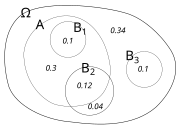
Illustration of conditional probabilities with an Euler diagram. The unconditional probability P(A) = 0.52. However, the conditional probability P(A|B1) = 1, P(A|B2) = 0.75, and P(A|B3) = 0.
In probability theory, conditional probability is a measure of the probability of an event given that another event has occurred.[1] If the event of interest is A and the event B is known to have occurred, "the conditional probability of A given B", or "the probability of A under the condition B", is usually written as P(A|B), or sometimes PB(A). For example, the probability that any given person has a cough on any given day may be only 5%. But if we know or assume that the person has a cold, then they are much more likely to be coughing. The conditional probability of coughing given that you have a cold might be a much higher 75%.
The concept of conditional probability is one of the most fundamental and one of the most important concepts in probability theory.[2] But conditional probabilities can be quite slippery and require careful interpretation.[3]
For example, there need not be a causal or temporal relationship between A and B. P(A|B) may or may not be equal to P(A) (the unconditional probability of A). If P(A|B) = P(A) (or its equivalent P(B|A) = P(B)), then events A and B are said to be independent: in such a case, having knowledge about either event does not change our knowledge about the other event.
Also, in general, P(A|B) (the conditional probability of A given B) is not equal to P(B|A). For example, if you have cancer you might have a 90% chance of testing positive for cancer. In this case what is being measured is that if event B ("having cancer") has occurred, the probability of A (test is positive) given that B (having cancer) occurred is 90%: that is, P(A|B) = 90%. Alternatively, if you test positive for cancer you may have only a 15% chance of actually having cancer because most people do not have cancer and the false positive rate for the test may be high. In this case what is being measured is the probability of the event B (having cancer) given that the event A (test is positive) has occurred: P(B|A) = 15%. Falsely equating the two probabilities causes various errors of reasoning such as the base rate fallacy. Conditional probabilities can be correctly reversed using Bayes' theorem.
References[]
- ↑ Gut, Allan (2013). Probability: A Graduate Course (Second ed.). New York, NY: Springer. ISBN 978-1-4614-4707-8.
- ↑ Ross, Sheldon (2010). A First Course in Probability (8th ed.). Pearson Prentice Hall. ISBN 978-0-13-603313-4.
- ↑ Casella, George; Berger, Roger L. (2002). Statistical Inference. Duxbury Press. ISBN 0-534-24312-6.

|
This page uses content from Wikipedia. The original article was at Conditional probability. The list of authors can be seen in the page history. As with the Math Wiki, the text of Wikipedia is available under the Creative Commons Licence. |